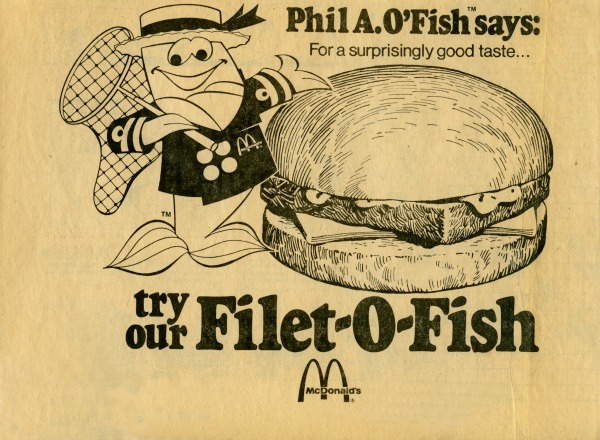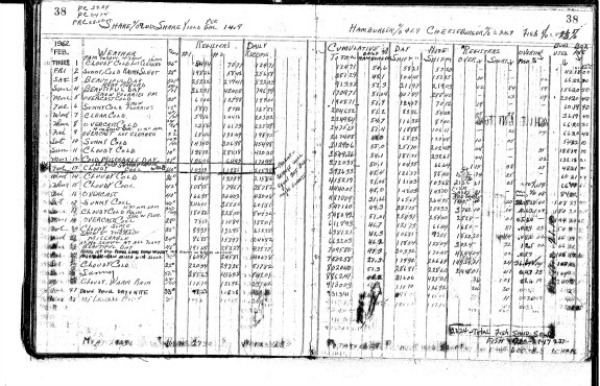The Fishy History of the McDonald’s Filet-O-Fish Sandwich
How a struggling entrepreneur in Ohio saved his burger business during Lent and changed the McDonald’s menu for good.

A Filet-O-Fish advertisement from 1976 featuring the elusive Phil A. O’Fish. Image courtesy of Archives, McDonald’s Corporation.
For a burger joint like Mickey D’s, the Filet-O-Fish sandwich is surprisingly popular: Pirates would give their arm for one and apparently, whales eat “boatloads” of them. The Atlantic-Pollock based lunch item is consumed at a rate of 300 million a year— 23 percentof them are sold during Lent, and we can thank the Catholics in Ohio and a struggling businessman for the fast food classic.
When Lou Groen opened the first McDonald’s in the Cincinnati area in 1959, business was tough. McDonald’s was new to the area—the McDonald brothers had only just begun to franchise their stores six years prior. Groen’s son, Paul, who worked at his father’s McDonald’s for 20 years straight and later bought a few of his own, remembers how hard his parents worked to keep the business alive in the beginning.
As a child, Paul was paid 10 cents an hour to pick up the parking lot and keep the kitchen clean. “McDonald’s wasn’t the brand it is today back then—people didn’t come to his little McDonald’s, they went to Frisch’s,” Paul says. According to a sales ledger from 1959 (pictured below), he and his wife made a total of $8,716 profit revenue in their first month of business.
“We make that much in one day now!” Paul says.
“Opening day, my father made $307.38 in sales. The restaurant only had two windows, one register at each window. There was no inside seating. How do you run a business on $300 a day? My mom and dad were just struggling to make it. My brother and sister worked for free for two years!”

The sales ledger from Lou Groen’s opening day of business, January 13, 1959, at his first McDonald’s in Monfort Heights, Ohio. Image courtesy of Paul Groen. Click the ledger for a larger version.
Though Lou Groen’s restaurant was one of 68 new franchises opened that year by founder Ray Kroc, there was something about Monfort Heights, Ohio, that didn’t bode well for a little-known burger joint during Lent: About 87 percent of the population was Catholic. When Groen was 89, he recalled to the Chicago Tribune News:
I was struggling. The crew was my wife, myself, and a man named George. I did repairs, swept floors, you name it. But that area was 87 percent Catholic. On Fridays we only took in about $75 a day.
Groen was working ungodly hours and had twins to feed at home—$75 was not cutting it. He noticed that a restaurant nearby owned by the Big Boy chain was doing something different—they had a fish sandwich. “My dad told me, ‘If I’m gonna survive, I’ve got to come up with a fish sandwich,’” says Paul. So Groen went to work creating a simple, battered, halibut-based prototype, with a slice of cheese between two buns.
He did his research, investigating what the Big Boys chain was doing right, trying out different cost-effective recipes. He brought the idea to corporate in 1961. “The Filet-O-Fish sandwich was groundbreaking. My father went through a lot to introduce that sandwich,” Paul says. “He made a number of trips to Chicago to present the idea to Ray Kroc.”
In 1959, access to top management was somewhat easier, Paul says. There was only a handful of operators that Kroc dealt with—rather than the thousands of operators that exist today. Owners like Lou received more guidance from upper management. According to an interview with Groen in the Business Courier in 2006, McDonald’s founder, Ray Kroc, was not all that excited about Groen’s fishy dreams at first:
“You’re always coming up here with a bunch of crap!” he told Groen. “I don’t want my stores stunk up with the smell of fish.”
But Kroc’s initial rejection of the idea may have come from a more selfish place. He had a meat alternative idea of his own, called the “Hula Burger,” a piece of grilled pineapple and cheese on a bun. But Kroc was willing to compromise: On Good Friday in 1962, both the Hula Burger and the Filet-O-Fish sandwiches would appear on the menu in selected locations—whichever sandwich sold the most would win. The final score? Hula Burger: 6, Filet-O-Fish: 350.
By 1965, the Filet-O-Fish, ”the fish that catches people”, became a staple on the McDonald’s menu nationwide among other greats like the Big Mac and the Egg McMuffin. Kroc would later recall the failure of his pineapple creation and the success of the sandwich in his biography Grinding it Out: The Making of McDonald’s noting:
“It was a giant flop when we tried it in our stores. One customer said, ‘I like the hula, but where’s the burger?’”
According to the sales ledger from 1962 (pictured below) the first time Groen’s halibut-based Filet-O-Fish was sold was Tuesday, February 13, 1962. (The whitefish sandwich we see today wasn’t officially put on the menu until 1963). “This sales ledger, or ‘the Bible’ as we used to call it, is an affirmation of the stuff I knew from the stories my father told me,” Paul says.”It really is a piece of family history—I look at these numbers here and I’m just amazed at the contrast.” In the first month of the Filet-O-Fish’s existence, 2,324 total fish sandwiches were sold. The McDonald’s corporation declined to provide current monthly averages.
Next to the total sales for February 13, the words “Predict—Fridays will equal Sat. Busi., maybe Sundays” are scratched into the margins of the record. Though Paul cannot confirm who initially scrawled this note onto the page, the prediction itself wasn’t too far off from what came to fruition: The success of the sandwich during Lent would far surpass Groen’s initial expectations.

The sales ledger from the first day the Filet-O-Fish sandwich was sold at Groen’s McDonald’s in Ohio. Image courtesy of Paul Groen. Click the ledger for a larger version.
The company has gone through plenty of advertisements for the sandwich, but one character in particular, remains somewhat elusive—Paul barely recalls the campaign. A cartoon by the name of Phil A. O’Fish had a brief stint as the face of the marketing campaign for Groen’s invention in 1976. But by ’77, the anthropomorphic sailor fish was nowhere to be seen, replaced by a simple advertisement that offered some “Food For Thought.”
By ’78 the “Deliciously Different” sandwich stood its ground sans smiley mascot.
The fishy, Irish cartoon for the sandwich emerged right when the McDonaldland characters were taking over Mcdonald’s ads and playscapes country-wide. Characters like the Hamburgerlar, Captain Crook, Mayor McCheese and—of course—Ronald McDonald were introduced in ’71 when the chain’s drive-ins were replaced by mansard-roofed restaurants. It was a fictional land that served as the basis for playgrounds attached to McDonald’s restaurants where french fries grew from bushes, burgers popped out of the earth like flowers by “Filet-O-Fish Lake” and was home to Ronald McDonald and all of his friends.
By 1979, the McDonaldland gang became the face of the “Happy Meal Toys” promotion—Phil A. O’Fish was sleeping soundly in Davy Jones’ locker by then. In 2009, a different fishy fellow took the spotlight with the popular “Gimme Back That Filet-O-Fish” commercial featuring a singing, bass wall decoration. It did so well on television and on YouTube, (reaching over one million views in 2009) that the corporation sold the singing fish commercially.
The Filet-O-Fish sandwich has featured real fish since Groen wrote up the recipe in the ’60s (believe it or not). Whether the fish was sustainable, however, was up for debate. In the past, the company as well as other chains like Long John Silver’s have used the New Zealand hoki fish, whose population has diminished significantly in the past few decades due to its wide commercial use.
But in late January, McDonald’s announced the addition of the sustainable blue “ecolabel” from the Marine Stewardship Council which certifies that the Alaskan Pollock used in the sandwiches come from places with sustainable fishing practices. According to the MSC, McDonald’s Corp. now gets all its fish in the U.S. from a single Alaskan Pollock fishery.
To celebrate the sandwich’s 50 plus years of existence, McDonald’s launched a new product just in time for Lent this year: Fishbites. The mini-morsels of battered and fried Atlantic Pollock are available through March 2013 in Philadelphia region restaurants. Though, if you ask the Groen family, Lou always said his orignal halibut-based recipe was better.
Groen passed away in May of 2011 and won’t be able to taste the new variation of his original recipe, but his legacy lives on with Paul, now 62, who took over two McDonald’s in Northgate and Tylersville when his father sold his 42 restaurants back to the company in 1986. Today, Paul owns 12 restaurants in Northern Kentucky along a 27-mile stretch of Interstate 75 and plans to pass the family business to two of his children.
Sign up for our free newsletter to receive the best stories from Smithsonian.com each week.
/https://tf-cmsv2-smithsonianmag-media.s3.amazonaws.com/accounts/headshot/561436_10152738164035607_251004960_n.jpg)
/https://tf-cmsv2-smithsonianmag-media.s3.amazonaws.com/accounts/headshot/561436_10152738164035607_251004960_n.jpg)